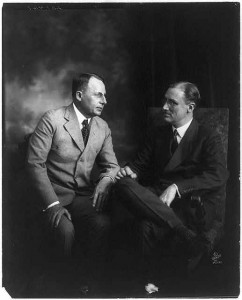On Tuesday, November 6, voters in the United States will go to the polls to elect a president and other political leaders. As Election Day approaches, this blog will be providing suggestions for ways to use primary sources from the Library of Congress to help students learn about the election process and past elections.
The election of 1920, for example, was tumultuous. World War I had ended. The current president, Woodrow Wilson, was incapacitated by a stroke and living as an invalid. Women were voting in their first presidential election. Many Americans were concerned about U.S. foreign policy and the possible entry of the United States into the League of Nations. There were riots in Chicago and other cities. In this time of change who would voters choose to replace Wilson?
With radio in its infancy, one way supporters got the message out to voters was through phonograph recordings of the candidates and their supporters. Some of those recordings can be found in American Leaders Speak . There are recordings of Republican Warren Harding and his running mate Calvin Coolidge and of Democrat James Cox and his running mate Franklin D. Roosevelt . One speech that may be of special interest is the recording made by Corrine Roosevelt Robinson. She was the younger sister of Theodore Roosevelt, who had been considered the front runner for the Republican nomination until his death in 1919. Speaking in support of Harding and Coolidge, she calls them 100% American.
What can your students learn from listening to these speeches?
- Have students compare the speeches of Harding and Cox using the primary source analysis tool. What are the issues each of them discusses in their speeches? Based on the events and issues of 1920 who would students choose and why?
- Listen to the speech of Corrine Roosevelt Robinson. What can students learn about Robinson from listening to her speech? Listen to the speech of Franklin Roosevelt. Why did she oppose him in this campaign?
- Compare the speeches of Theodore Roosevelt and Franklin Roosevelt. What can you learn about each man from his speech? What are the issues of most importance to each?
- Ask students if looks or how a person dresses might sway voters, and then share pictures of the speakers. Does this change their opinion of the speakers? Why or why not?
What teaching strategies will you use to help students learn more about the upcoming election?


